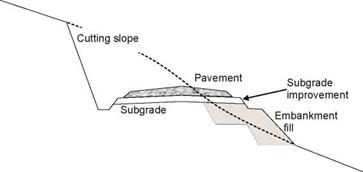Pavements and Earthworks
In today’s world almost all traffic runs on an improved surface and not on the natural soil profile… and most users give such improved surfaces little thought. This improved surface is known as a pavement and may be a simple layer of imported aggregate or the structure that comprises a modern expressway. In fact, all but the very simplest pavements comprise a series of carefully designed layers of imported, selected, construction materials placed on the “subgrade” (Fig. 1.4). The subgrade
|
Fig. 1.4 Indicative highway cross section |
may either be the natural soil profile encountered at the site (e. g. when the pavement construction is built at the same level as the surrounding ground, or when it is built in a cutting) or it may be a “fill” material that has been imported to create an embankment.
This fill is often subgrade soil from some other location, but might also be a byproduct or waste material. Even in a cutting, some material may have been imported to form the subgrade as it can aid drainage – and thus improve the performance of the pavement. Material specifically designed to provide an improved subgrade is known as “capping”. It may either be imported or may be achieved by some improvement technique applied to the natural subgrade in-situ (Fig. 1.4).
It is not only the pavement that needs draining; drainage of embankments and cuttings is also important to give soil-based slope stability and longevity of performance.
Finally, what about “moisture” and “water”? Both terms are used, more or less synonymously in this book. In general the direct term “water” is preferred to the more indirect term “moisture”, although “moisture” is often used to describe water in the unsaturated parts of the sub-surface.







Leave a reply